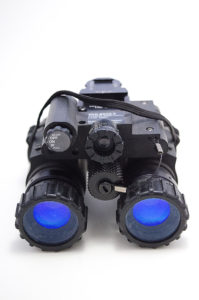
In previous posts of this series I covered helmets and hearing protection. Next up is night vision.
Night Vision
If your team has the opportunity to purchase night vision optics for the entire team or just some of your unit, go for it.
Night vision is a windfall for SWAT teams. The ability to work in total darkness gives a well-trained SWAT team a significant tactical advantage.
What is Night Vision?
There are a few different systems that let the user see at night. I am going to discuss light amplification systems.
If you are hoping to equip every member of a SWAT team, light amplification is the most economical (though it won’t feel that way) and practical choice because proper threat identification is essential in law enforcement.
No Matter the Tubes, Train
On occasion, I hear other SWAT cops complain about not having better night vision (single vs dual tube complaints mostly).
I have used single and dual tube systems. All things being equal, I believe dual tubes are better than single tubes; two tubes provide much better depth perception.
However, if your team is not consistently training with what night vision you have, you might as well not have it.
Solid operating procedures, the ability of your team to work together, and your familiarity with your equipment while in total darkness is the advantage of night vision.
Not the specific night vision device you have. So, train, train, train.
The Basic Night Vision System
Night vision devices and all the associated equipment with it are a system unto itself.
I am going to talk about the bare essentials for a team that will be consistently training with and using their night vision on operations.
The major parts are:
- The night vision device itself. This can be a single or dual tube device
- The mounting arm that is the interface between the night vision device and the helmet shroud/mount
- The helmet shroud, which is where the arm attaches to the helmet
When selecting a night vision device and its mounting options do not go low quality.
If you try to save a few hundred dollars by selecting an off brand night vision device and mounting accessories from Bob’s Discount NVG Bin, you will be sorry. That is not a promise, but a guarantee.
Other Essential Night Vision Accessories:
A Retention Device
When (because you will) you bump/crash into something, run into someone, or mount your NVG incorrectly, and it falls off your helmet, the retention device will keep your NVGs from falling to the ground.
Many helmets have integrated options for night vision retention devices. There are also quality after-market leashes available. A simple and effective way is a little bit of gutted parachute cord attached to a helmet screw and then tied to the NVG.
The choice of type is yours; just make sure you select some method of retention.
Counter Weights
NVGs are front heavy, especially dual tube systems. Counter weights will keep your helmet from being front heavy and significantly reduce neck fatigue.
Sacrificial Lenses
These lenses protect the objective lens (the lens in the front) of the night vision tube from being broken. Sacrificial lenses cost around $30, instead of $1,500+ for a new objective lens. $30 or $1500, the choice is yours…
Demist Shield
They prevent rapid temperature changes from fogging up your night vision device. Like when you go from an air conditioned vehicle into humid air outside the vehicle.
IR Strobe
A flashing light that can help identify individual team members in large open areas. It is only visible to those wearing night vision. It is also useful coordinating operations with overhead aircraft that have night vision capability.
Helmet Chin Strap
Ops-Core makes a helmet strap system with a more comfortable geometry, better adjustability, and support specifically for night vision goggles.
A Helmet Light
You will need a secondary light source that is easy to access. Look for a device that has low white light output (10 lumens) as well as night vision friendly color (red, green, or blue)
The Other Half of the Equation
If your team plans on using lethal force to engage identified threats while under night vision, an infrared aiming laser is a necessity.
Again, not for the financially faint of heart, and an item that requires you to do your homework before you buy.
Training with NVGs
Before you start training with night vision you want to make sure your team has solid SOPs (especially for CQB). If you don’t, there is going to be a lot of crashing into each other when the lights go out and the night vision goes on.
Training with your NVGs does not need to be elaborate to be effective. If you are just getting started all you really need is a room or two that you can turn the lights out in or cover the windows.
Break your training day in half with the first half being white/low light problems. For the second half of your day work with your night vision but start were you began with your white/low light training.
Wrap Up
Once you make a decision on NVGs and your equipment arrives, remember your team’s performance in the darkness is not determined by how advanced their NVGs are, but how consistently you train with them.
Purchase quality equipment you can afford for your team and train with it consistently.
And to the guys who run into a wall instead of a door, or who have a night vision collision with a teammate; it happens.
Part 4 is up next and will cover a two general but important head mounted items.
